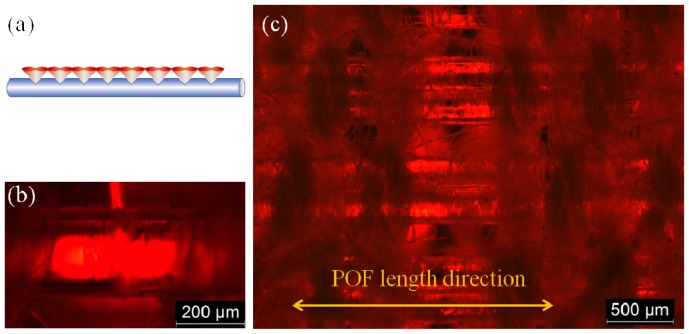Abstract
In this paper, a flexible luminous fabric device was developed and investigated for wearable three-dimensionally fitted low-level light therapy. The fabric device exhibited excellent optical and thermal properties. Its optical power density and operating temperature were stable during usage for 10 hours. In vitro experiments demonstrated a significant increase in collagen production in human fibroblast irradiated by the fabric device, compared with the fibroblast without light irradiation. A series of tests were conducted for the safety of the fabric for human skin contact according to ISO standard ISO 10993-1:2003. The results showed that there was no potential hazard when the luminous fabrics were in direct contact with human skin.
OCIS codes: (000.1430) Biology and medicine, (120.3890) Medical optics instrumentation
1. Introduction
Phototherapy is one of the oldest therapeutic modalities used to treat various health conditions. Sunlight benefits in treating skin diseases have been exploited for more than thousands of years in ancient Egypt, India, and China [1]. Advances in laser technology have progressed so rapidly during the past decades that successful treatments have been developed and used for many cutaneous concerns and congenital defects, including vascular and pigmented lesions, tattoos, scars, and unwanted hair [2]. Phototherapy is also the therapeutic method which depends on light sources such as sunlight initially [3, 4], followed by carbon arc lamp [5], incandescent lamp [6], fluorescent lamp [3], then laser with various wavelengths [7, 8], light emitting diodes (LEDs) and so on [9]. Hence various devices have been developed for phototherapy. After low-level intensity light sources were applied in medical research, low-level light irradiation has been identified more effective in some clinical treatment of disorder, as wound healing, photo-rejuvenation, anti-inflammation and so on [10, 11], which was named low-level light therapy.
Low level red and near infrared light therapy (600 ~950 nm, less than 50 mW/cm2) has been used in pain reduction, photo-rejuvenation, treatment of sunburn, edema, wound healing and anti-inflammation [10]. The biological effects are directly caused by photo-modulation for the tissue, not by heating in which the range of temperature rising is limited from 0.1 to 5°C. Currently, light therapy is applied in clinics where patients are exposed to the light source for a given period of time. The clumsiness of the light source and requirement of physical presence in the clinics causes inconvenience to the patient, unnecessary time spent at clinics. A wearable, programmable, comfortable and ubiquitous photonic device will alleviate the burdens on both clinics and patients from normal light therapy procedure.
Smart textiles, defined as the textile materials that sense and respond to environmental conditions or external stimuli in a manual or programmed manner [12] are ideal candidates for wearable light therapy because of their flexibility, light weight, comfort and convenience. The applications of smart textiles range from monitoring environmental conditions to wearable electronic and photonic devices integrated into every day clothing [13]. Most of these devices use electrical and electronic textiles [14, 15], wearable photonics [16–19] and wireless body sensor network technologies [20] to precisely and noninvasively measure wearer’s physiological signals including temperature, electrocardiograph (ECG), electroencephalograph (EEG), pulse, respiration rate, blood pressure, blood glucose, etc, together with other parameters such as environmental temperature, body motion, workload, location and so on [21]. Up to now, a limited number of smart textile products have been explored for remedial purposes.
Fabrics which integrate with side-emitting polymer optical fiber (POF) have great potentials to be used for phototherapy. A large number of tightly intertwined POFs in fabrics enable efficient two-dimensional light emission in a large area, delivered by a laser or LEDs with an appropriate wavelength. Combined with deformability, the fabric devices can easily fit into three dimensional contours like human body with superior air permeability, light weight, flexibility and wearing comfort. However, most recent works about POF fabrics have focused on illumination, displays and POF sensors. For luminous POF fabric devices to be applied in phototherapy, several key issues are required to be investigated: materials; design and fabrication of fabrics and devices; performance and reliability; safety of POF fabric devices.
In this paper, a luminous fabric device was designed and made purposely. The performance of the device was evaluated experimentally. For comparison, an LED array device was fabricated and characterized in parallel. In vitro experiments were conducted to study collagen synthesis of human skin fibroblast irradiated by the POF fabric and LED array devices. The safety of the POF fabric for human skin was evaluated according to ISO 10993: 2009 Biological evaluation of medical devices [22–24].
2. Mechanism of luminous fabrics
Three-dimensional (3D) conformability is much desired for phototherapy device that can be worn on human body. Textile fabrics seem to be ideal substrates for this kind of arrangements to fulfill specific photometric or radiometric requirements. A POF is a cylindrical dielectric waveguide that is usually used to transport light between the two ends of the fiber by the process of total internal reflection. By creating certain features in the core or at the core-cladding interface of the fiber, the POF emits light sideway, which offers possibilities for large-area 3Dillumination [25].There are also many works attributed to the surface treatment methods to provoke side-emitting light. Mechanical side-notching [26] allows simple figures of light dots. Surface mechanical abrasion [27], surface chemical etching [28] or sandblasting leads to a more even light distribution. Alternatively, writing Bragg gratings or adding scattering particles in the fiber core also can evoke light emission [29, 30]. Photonic bandgap fibers with well-defined geometrical structure can achieve controllable side emission [31].The light also can leak out when stretching a grooved POF loop [32]. Besides, Laser micromachining method also was explored to treat POFs to evoke light leakage [33].The mechanical methods to surface treat POF are easy and controllable to achieve better side emission effect. V-groove is one feature that can be created on the POF by mechanical method to provoke light side emission, as shown in Fig. 1 . The power of side emission light from V-groove can be calculated. The calculated results show that the amounts of light refracted out primarily depend on the shape of the V-groove and the refraction indices of both the fibers’ core and the core environment. When the double-end coupling is selected, symmetrical V-grooves with about half-angle are the optimal option for 250 μm POF in order to obtain the maximum of light refracted out from the fiber Y-X plane while the full theoretical analysis is still under development. To obtain the maximum side-emission, V-grooves with optimal shape can be made on the surface of POF in fabric, as shown in Fig. 2 .
Fig. 1.
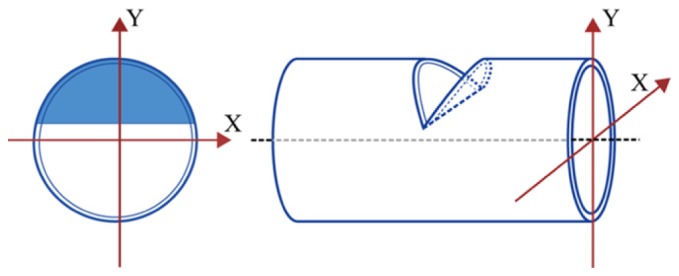
Segment of POF with V-groove
Fig. 2.
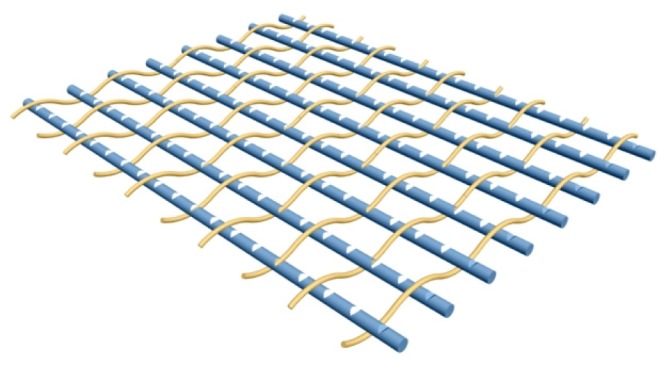
Schematic of the POF Fabric with V-grooves
3. Light power emitting from luminous fabric
A light source, an essential and core component for phototherapy, is specified by the distribution of power among all the ray directions emitted from each differential element of its surface area. Light emitted at angle to the normal has intensity per unit solid angle per unit area of source. Thus the element of power radiated is given by
| (1) |
where Ω is the element of solid angle.
The light source is located in a uniform medium, air, of refractive index() and placed against the fiber end face. It is assumed that the angle of the radiation pattern of the light source is larger than the fiber acceptance angles is normally the case in practice. Only light within a certain cone can enter in or emit from the end face of a multimode optical fiber, known as the acceptance cone of the fiber. Hence the amount of surface power carried by the bound rays,, can be calculated as,
| (2) |
where S0 is the end area of POF.
As shown in Fig. 3 , when V-grooves are created on the surface of the POF, a part of light travelling in the POF refract out from the face of V-groove because these light rays cannot satisfy the condition of light transmission in the fiber. Some light rays in them may reenter the fiber via the other face of V-groove. In this paper, a two-dimensional case of Y-Xplane is considered, thus only the Y-X modes of propagation are included as the first-step of analysis.
Fig. 3.
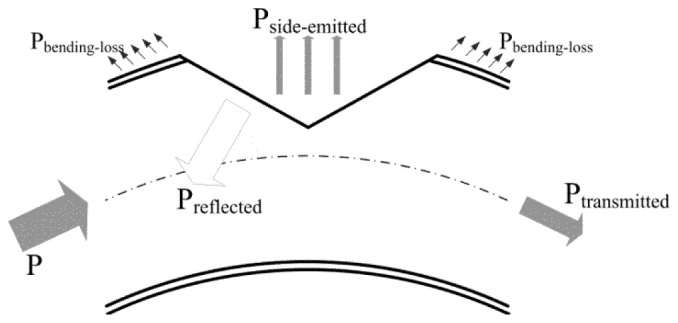
Light propagation in the POF with V-grooved notch
The refractive light power passing through one face of V-groove and eventually entering into air,, is,
| (3) |
whereis effective area in one face of V-groove for light refracted into air, is the angle of refraction light to the normal.
For a POF with multiple V-grooves, we record the side-emission power from the first groove as,
| (4) |
The power ratio of the side-emission power to the incident power for each groove is assumed to be the same because of the assumptions that mutually independent groove with the same parameters. Hence the side-emission power from the second groove is,
| (5) |
The same procedure is repeated for the following grooves and for the Nth groove the side-emission power is,
| (6) |
The total side-emission power for a POF with multiple V-grooves is,
| (7) |
For a wovenfabric with m filaments/cm POF density, V-groove is created on the POFs in fabric with density n/cm. The power density of side-emitting light from luminous POF fabric can be calculated using the below equation,
| (8) |
4. Fabrication methods
4.1 Luminous POF fabric device
POFs (ESKATM, CK-10, supplied by Mitsubishi Rayon Co., Ltd, Japan) were step index optical fibers with a polymethyl methacrylate(PMMA) fiber core and a fluorinated PMMA derivative cladding. Fiber diameter is 250μm, NA = 0.5. They were woven as the weft yarn with cotton yarns (80s/2, Central Textile, Hong Kong) as the wrap yarn. The POF fabric was woven by an automatic loom (Jakob MÜller, Frick, Switzerland). The fabric structure was plain weave. The measured weft cover factor is 55.7% and the warp cover factor is 33%. Figure 4 shows that the POF fabric is so flexible that it can be fit in three dimensional configurations for wearable devices. The inset illustrates the enlarged fabric structure where the POFs are arranged in the horizontal directions with good exposure of light emitting spots and air permeability. In order to guarantee all the V-grooves were placed on the same face of the fabric, V-grooves were created on the POFs after weaving by a serrated tool. The half-angle of all teeth for the serrated tool was made as 33°C according to calculation to obtain maximum side emission from the Y-X plane. The V-grooves were implemented on the POF by single-directional and vertical to the fiber axis abrading of the surface using this tool.
Fig. 4.
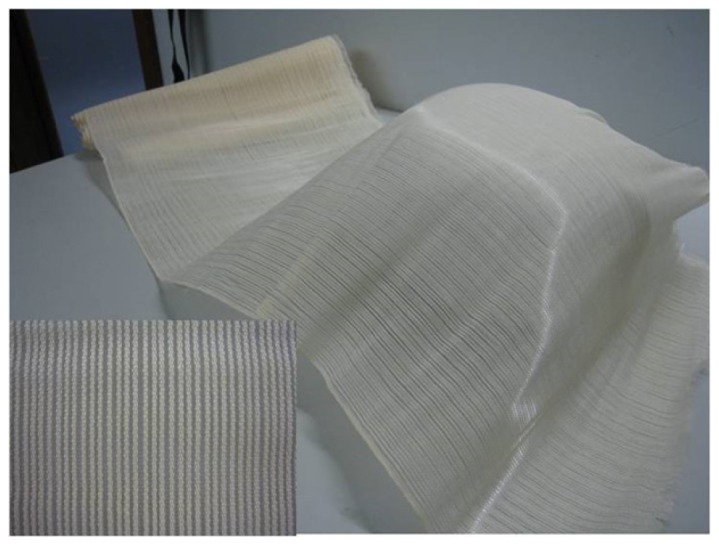
Photo of woven fabrics produced from cotton yarns and POF of 250 μm diameter (inset: enlarged image)
The appropriate wavelength is essential for phototherapy because cellular reactions exhibit specificity to irradiation wavelengths. Many previous studies showed that low level light irradiation at about 630 nm provides low energy stimulation to tissues, which results in increased cellular activity, increased proliferation rate of fibroblasts and keratinocytes, as well as enhancement collagen production [34].As PMMA based POF have excellent transmission attenuation in the visible range, coupling with LED of 630 nm is a critical part of the fabrication of devices. 185 POFs with polished ends were put together and connected with one LED by an optical adhesive, NOA 65(Norland Products Inc., USA). The LED has a Lambertian radiation pattern, that the radiation angle is 120°, larger than the fiber acceptance angle [35]. The fibers were double-end coupled with LEDs and the coupling efficiency was 43.2%. In order to guarantee the uniformity of irradiation of POF fabric, two layers of the same POF fabric were used. Figure 5 shows the scheme of luminous POF fabric device. The POF fabrics were encapsulated by a black foam and connected with electrical circuit and power source(Lithium battery, CR123A, Panasonic, Japan), as shown in Fig. 6 . The radiation area was57 mm × 43 mm suitable for biological in vitro experiments.
Fig. 5.
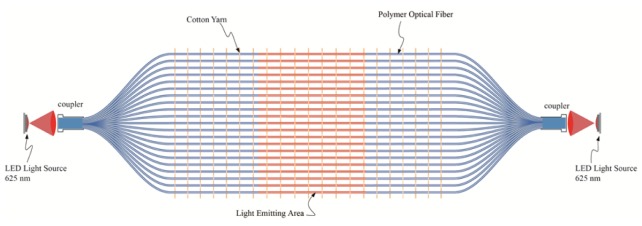
Scheme of luminous POF fabric device.
Fig. 6.
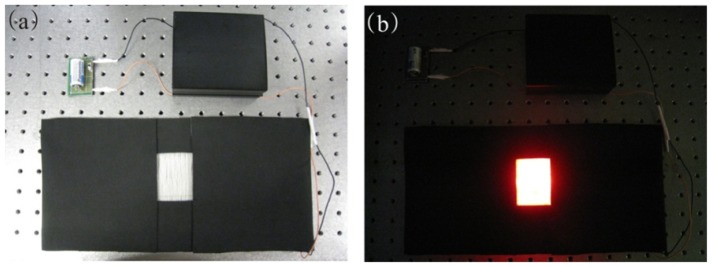
Fabric device used for in vitro experiments (a) in day light; (b) in dark.
4.2 LED array device
A LED array device was also fabricated in order to compare the effect on cells with the POF fabric device. This device consists in an array with 15 LEDs (3 rows by 5 columns), connected electrically in a parallel configuration, as shown in Fig. 7 . The forward currents and voltages of LEDs change with the adjustable resistor so that the light radiation intensity also changes correspondingly. The optical adhesive, NOA65, was casted into a cube (57 mm × 43 mm × 4 mm) covering onto the LED array in order to reduce attenuation in air and make light radiation uniform. The circuit board, wires and power source were also placed into the box.
Fig. 7.
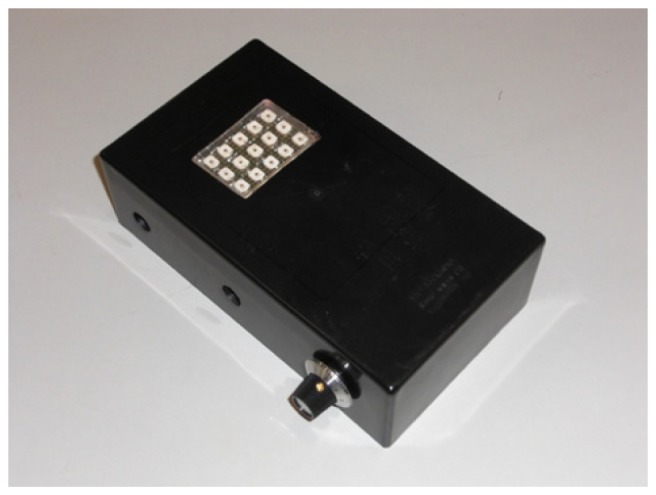
LED array device for in vitro experiments
4.3 Optical and thermal properties
Previous studies showed that exposure to low-level red or near infrared light manipulate or regulate cell activity, achieving therapeutic effect [36]. Hence enhanced thin film LED with 625 nm peak wavelength (Golden DRAGON®, OSRAM Opto Semiconductors, USA) was selected for the light source, as confirmed by the emission spectra measured by optical spectrum analyzer (AQ6315A, Ando Electric CO., LTD, Japan).
Stable light output and temperature are two prerequisites of a successful therapy. Hence the variations of light power density and variations of temperature and relative humidity in long time were measured respectively. The power density was measured every 30 minutes by an optical meter (Optometer P9710, Gigahertz-Optik, Germany). Each data point was averaged by five locations. The variation of light power density due to bending was measured by bending the fabric over a curved surface with known curvatures.
The two devices were placed into an environmental chamber (C7-600, VÖTSCH, Germany). The culture dishes were put on the light-emitting area of two devices as those in the in vitro experiments. A relative humidity &temperature sensor (SHT1x, Sensirion, Switzerland) was stick on the bottom of inside culture dish. The sensor recorded the data of temperature and relative humidity in real time and sent them to a computer by wireless Blue Tooth protocol. The temperature and relative humidity of the environmental chamber was set at 37 °C and 90% respectively, which also was measured.
4.4 In vitro experiment
Low-level red light therapy has been applied to various medical conditions such as wound healing, tissue repair, relief of pain and inflammation, photo-rejuvenation, sunburn prevention and other dermatologic diseases [37, 38]. The low-intensity red light appears capable of affecting cellular processes in the absence of thermal effects, for instance, promoting the synthesis of collagen in fibroblasts. Hence in our work, the collagen synthesis in human skin fibroblasts was selected for study.
The collagen synthesis was examined in human fibroblasts irradiated by POF fabric or LED array device. Human fibroblasts (kindly provided by Dr. Raymond Siu-ming Wong from Haematology and Toxicology, Department of Medicine and Therapeutics, Prince of Wales Hospital, The Chinese University of Hong Kong) seeded in the 4 wells chambers for 24 hrs were prepared for the light illumination. Cells were then exposed to a single dose with the POF fabric device (634 nm, irradiation intensity: 0.1449 mW/cm2 and the energy density: 3 J/cm2) for 5.75 hours or with LED array device(634 nm, irradiation intensity: 0.1424 mw/cm2 and the energy density: 3 J/cm2) for 5.9 hours. After a further incubation of 4 days, cells were fixed in acetone/methanol and then washed with phosphate buffered saline. Diluted primary polyclonal rabbit antibody linked with biotin (Lifespan) against human collagen I was added. After washing with phosphate buffered saline, fibroblasts were incubated with diluted secondary mouse antibody (BD Pharmingen) which was linked to both streptoavidin and horseradish peroxidase. After washing with phosphate buffered saline, 3,3diaminobenzidine (DAB) chromogen substrate in DAB (BD Pharmingen) buffer was added. Human fibroblasts labeled with primary and secondary antibodies linked with the peroxidase would convert the DAB substrate into brown precipitate which indicated the presence of type I collagen protein. Lastly, cells were examined under light microscope and recorded.
4.5 Safety consideration
The POF fabric device is intended to come in direct contact with the three dimensional human body, as shown in Fig. 8 . Hence POF fabric was evaluated for its safety referred to the relevant standards from International Organization of Standardization (ISO). According to ISO 10993-1:2003 Biological evaluation of medical devices–Part 1: Evaluation and testing [22], three kinds of evaluation test were conducted, in vitro cytotoxicity, skin sensitization and skin irritation. The experiments completely followed the guidance of ISO 10993 standards [23, 24]. Relevant tests were conducted in certificated Shenzhen Testing Center of Medical Device, Shenzhen, China.
Fig. 8.
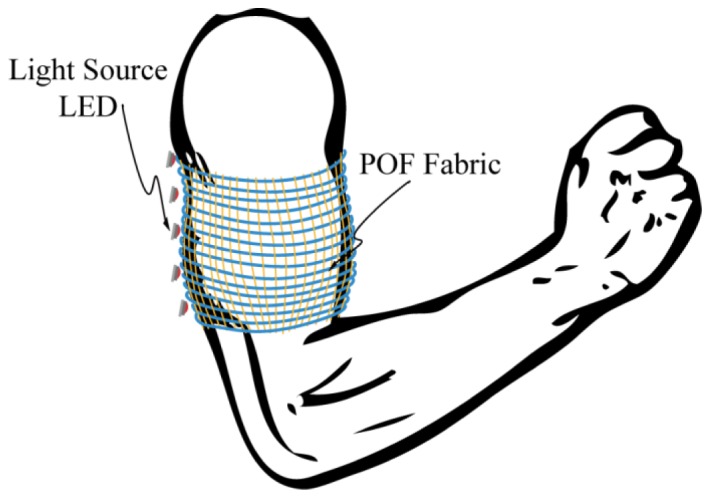
An example of the phototherapy device used in practice
5. Results and discussion
5.1 Optical and thermal properties of POF fabric and LED array devices
The measured emission spectrum of the LED was shown in Fig. 9 . The sharp peak wavelength of LED is located at 634.3 nm. There is little light in other wavelength range.
Fig. 9.
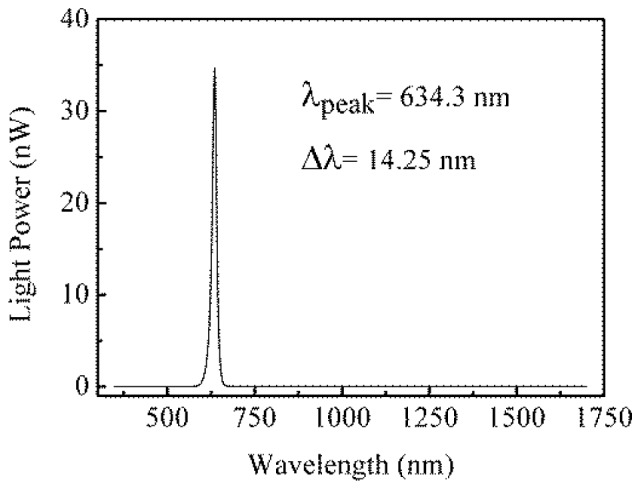
Emission spectra of red LED (6546417)
The power densities of two devices are almost constant up to 10 hours, as shown in Fig. 10 . The average power densities of POF fabric and LED array devices are 0.1449 mW/cm2 and 0.1424 mW/cm2, respectively. The power density of POF was decreased by 12% when the POF fabric was bent towards the V-groove side with a curvature radius of 4 cm.
Fig. 10.
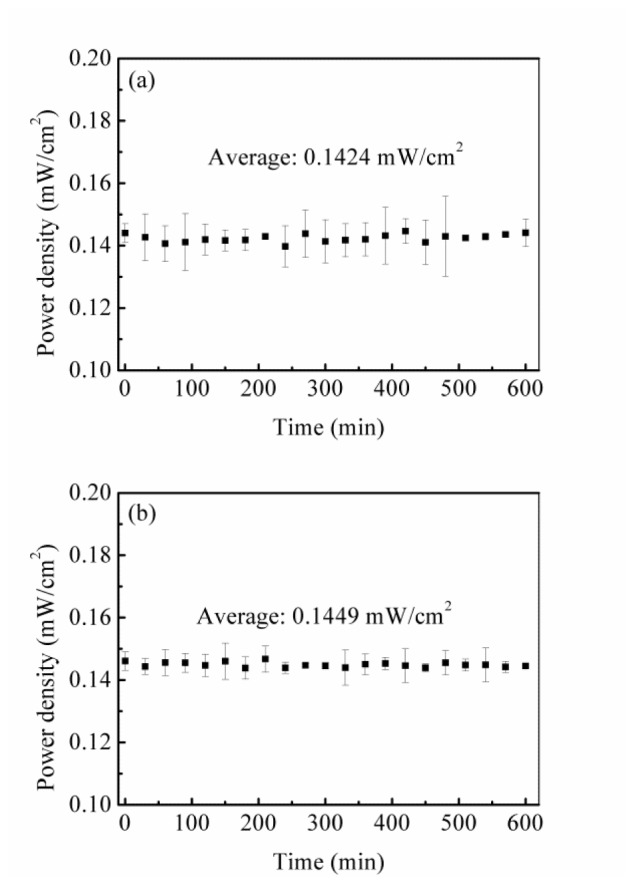
Variation of power density during 10 hours (a) LED array device; (b) POF fabric device
Figure 11 shows the thermal and humidity stability of the devices. The environmental chamber was set at constant temperature 37.5°C and relative humidity 90% as shown in Fig. 11(a). The variations of temperature and relative humidity at the bottom of inside culture dish irradiated by LED array and POF fabric device are displayed in Fig. 11(b) and Fig. 11(c), respectively. Both temperature and relative humidity do not have significant fluctuation for the two devices. However, the temperature fluctuation of the dish bottom irradiated by the LED array is larger than that of the dish irradiated by POF fabric.
Fig. 11.
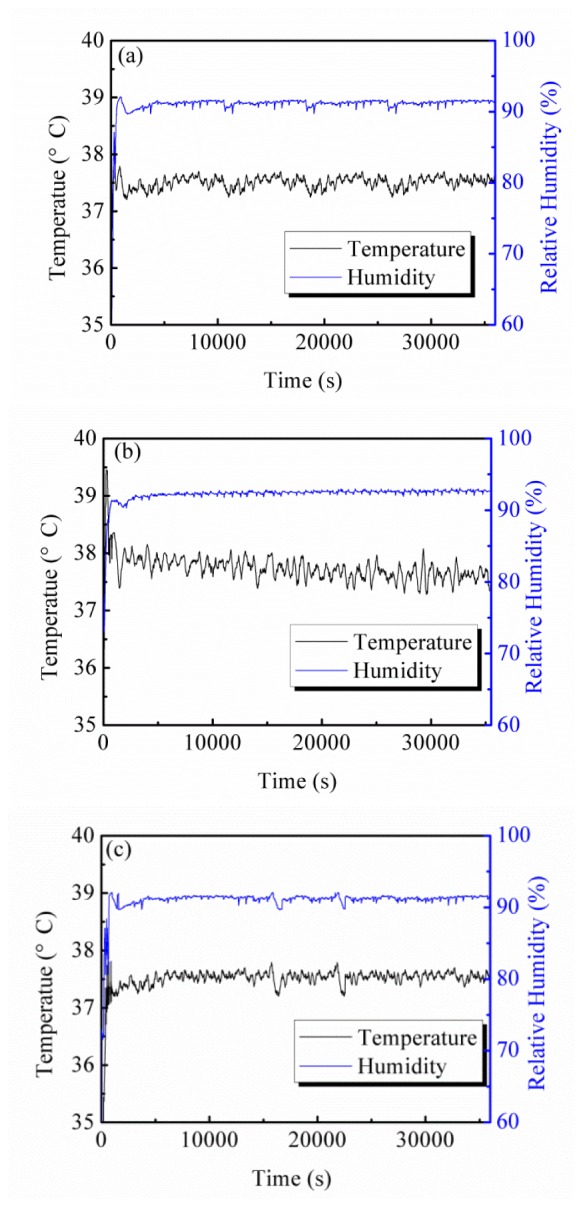
(a)Temperature and relative humidity in the chamber. (b) LED array device; (c) POF fabric system device
5.2 Response of cells irradiated
As demonstrated in Fig. 12(b) , a significant increase in collagen production is observed in human fibroblast when these cells were irradiated by the LED array device(634 nm, irradiation intensity: 0.1424mW/cm2 and the energy density: 3 J/cm2) for 5.9 hours and then incubated 4 days, compared with fibroblast which were incubated without light irradiation (Fig. 12(a)). Compared with the control group (Fig. 12(c)), the collagen production also increased for human skin fibroblasts exposed to POF fabric device (634 nm, irradiation intensity: 0.1449 mW/cm2 and the energy density: 3 J/cm2) for 5.75 hours as shown in Fig. 12(d). The result distinctly states that POF fabric device has the similar beneficial effect for human skin fibroblasts as the LED device. However, compared with the results of LED array device and POF fabric device (Fig. 12(b) and Fig. 12(d)), it seems that the effect of LED device is better than POF fabric device in this experiment of identical time. In practice, POF is light, air-permeable and flexible thus comfort for the wearer. It can be worn for a longer period so that total dosage of radiation can be adjusted so that the treatment effect is kept the same. The amount of collagen produced in cells irradiated by LED is larger than that exposed to POF fabric using the same irradiation parameters. This difference may be attributed to the light field distribution due to different emitting mechanisms, LEDs have emitting cones while the POF has many v-grooves emitting light predominantly in the plane inclined with a fixed angle towards the fabric plane.
Fig. 12.
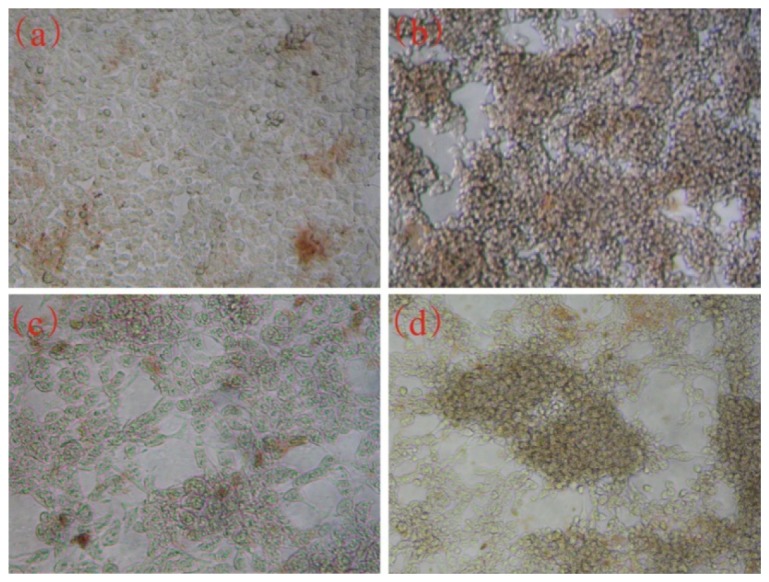
Expression of human collagen type I from human fibroblasts. Three independent experiments were conducted and representative results are shown. (a) (c)cells incubated without light irradiation; (b) cells irradiated by LED array device; (d) cells irradiated by POF fabric device
To further elaborate the possible cause of this difference, let's look at the light distribution in details. The light was coupled into the fiber from two ends of fiber and then transmitted along the fiber based on total internal reflection. When the light touches the faces of V-groove, some part of light can be refracted out from the fiber to the air because these light rays cannot satisfy the total reflection condition in the POF. Most of refraction light distributes along with the fiber length direction and there is less light at the vertical direction of fiber as shown in Fig. 13(b) . The reason of this optical field is that the faces of V-groove created on the fiber are towards the light propagation direction. Multiple V-grooves are arranged along the fiber length direction as shown in Fig. 13(a). Hence this kind of side-emitting fiber is close to a linear light source. The whole luminous POF fabric is composed of many parallel optical fibers, that is many line lights. This was also verified by the micrograph of luminous POF fabric, shown in Fig. 13(c). From Fig. 13(c), it is obvious that the optical field distribute linearly. On the other side, LED used in this paper is considered as Lambertian emitter exhibited a Lambertian light distribution [35, 39].The light distribution is a cone, identical in all direction within a cross section, which is different from that of fiber with V-grooves. Hence the difference of spatial light distribution of two devices maybe cause the different response of cells irradiated. The results also indicate a possible way to overcome this deficiency is to arrange the fibers in the fabrics randomly so than the field is more uniform.
Fig. 13.
(a) The schematic of light distribution of single POF with V-grooves; (b) The light distribution at one V-groove; (c) The light distribution of POF fabric
5.3 Safety of POF fabric for human skin
Three relevant experiments, in vitro cytotoxicity, skin sensitization and skin irritation, were conducted according to ISO 10993-1:2003 Biological evaluation of medical devices–Part 1: Evaluation and testing [22]. The experimental results indicated that the POF fabric was not considered cytotoxic and did not cause delayed dermal sensitization and skin irritation. Taken together, it is concluded that the POF fabric can be used in direct contact with human skin and does not pose risk to the human.
6. Conclusions
Luminous fabric device was developed and investigated for wearable three-dimensionally fitted low-level light therapy. The flexible fabric device showed excellent optical and thermal properties. Its optical power density and operating temperature were stable during usage for 10 hours. In vitro experiments were conducted to study collagen synthesis of human skin fibroblast, which was irradiated by the fabric device. A LED array device was fabricated and used for comparison with the same radiation dose at the energy density of 3 J/cm2. A significant increase in collagen production was observed in human fibroblast when these cells were irradiated by either the LED array or fabric device, compared with the fibroblast without light irradiation. However, it seems that the effect of the LED device is slightly better than that of the fabric device. Further investigation showed non-uniform light field distribution of the fabric device may contribute to this phenomenon, which is related to the fabric structure and needs to be further studied. Lastly, the safety of fabric for human skin contact was evaluated according to standard ISO 10993-1:2003. The evaluation results show that there is not potential hazard when the POF fabrics are in direct contact with human skin.
Acknowledgements
Shen Jing gratefully acknowledges a postgraduate scholarship received from the Hong Kong Polytechnic University. The authors wish to thank Dr. Raymond Siu-ming Wong from Haematology and Toxicology, Department of Medicine and Therapeutics, Prince of Wales Hospital, The Chinese University of Hong Kong for his support in the in vitro experiments and cell samples.
References and links
- 1.L. I. Grossweiner, The Science of phototherapy: an introduction (Springer New York, 2005) [Google Scholar]
- 2.Tanzi E. L., Lupton J. R., Alster T. S., “Lasers in dermatology: Four decades of progress,” J. Am. Acad. Dermatol. 49(1), 1–34 (2003). 10.1067/mjd.2003.582 [DOI] [PubMed] [Google Scholar]
- 3.Roelandts R., “The history of phototherapy: something new under the sun?” J. Am. Acad. Dermatol. 46(6), 926–930 (2002). 10.1067/mjd.2002.121354 [DOI] [PubMed] [Google Scholar]
- 4.Cremer R. J., Perryman P. W., Richards D. H., “Influence of light on the hyperbilirubinaemia of infants,” Lancet 271(7030), 1094–1097 (1958). 10.1016/S0140-6736(58)91849-X [DOI] [PubMed] [Google Scholar]
- 5.Montgomery F. H., “The present status of phototherapy,” J.Cutan. Dis. 21, 529–548 (1903). [Google Scholar]
- 6.Tan K. L., Boon W. H., “A simple method of phototherapy: inexpensive, blue incandescent bulbs,” Clin. Pediatr. (Phila.) 13(12), 1048–1051 (1974). 10.1177/000992287401301213 [DOI] [PubMed] [Google Scholar]
- 7.Houk L. D., Humphreys T., “Masers to magic bullets: an updated history of lasers in dermatology,” Clin. Dermatol. 25(5), 434–442 (2007). 10.1016/j.clindermatol.2007.05.004 [DOI] [PubMed] [Google Scholar]
- 8.Boixeda P., Calvo M., Bagazgoitia L., “Recent advances in laser therapy and other technologies,” Actas Dermosifiliogr. 99(4), 262–268 (2008). 10.1016/S0001-7310(08)74674-X [DOI] [PubMed] [Google Scholar]
- 9.Barolet D., “Light-emitting diodes (LEDs) in dermatology,” Semin. Cutan. Med. Surg. 27(4), 227–238 (2008). 10.1016/j.sder.2008.08.003 [DOI] [PubMed] [Google Scholar]
- 10.Vladimirov Y. A., Osipov A. N., Klebanov G. I., “Photobiological principles of therapeutic applications of laser radiation,” Biochemistry Mosc. 69(1), 81–90 (2004). 10.1023/B:BIRY.0000016356.93968.7e [DOI] [PubMed] [Google Scholar]
- 11.Sebbe P. F., Villaverde A. B., Moreira L. M., Barbosa A. M., Veissid N., “Characterization of a novel LEDs device prototype for neonatal jaundice and its comparison with fluorescent lamps sources: phototherapy treatment of hyperbilirubinemia in wistarrats,” Spectros. 23(5-6), 243–255 (2009). 10.1155/2009/761981 [DOI] [Google Scholar]
- 12.X. M. Tao, Smart Fibres, Fabrics and Clothing (CRC press, 2001). [Google Scholar]
- 13.S. Jung, C. Lauterbach, M. Strasser, and W. Weber, “Enabling technologies for disappearing electronics in smart textiles,” in Proceedings of IEEE Conference on International Solid-State Circuits (San Francisco, 2003), pp.386–387. 10.1109/ISSCC.2003.1234347 [DOI] [Google Scholar]
- 14.Rantanen J., Impio J., Karinsalo T., Malmivaara M., Reho A., Tasanen M., Vanhala J., “Smart clothing prototype for the arctic environment,” Pers. Ubiq. Comp. 6(1), 3–16 (2002). 10.1007/s007790200001 [DOI] [Google Scholar]
- 15.Shu L., Hua T., Wang Y. Y., Li Q., Feng D. D., Tao X. M., “In-shoe plantar pressure measurement and analysis system based on fabric pressure sensing array,” IEEE Trans. Inform. Technol. Biomed. 14, 767–775 (2010). [DOI] [PubMed] [Google Scholar]
- 16.Tao X. M., “Nerves for Smart Clothing – Optical Fibre Sensors and their Responses,” Intern. J. Clothing Sci. Technol. 14(3/4), 157–168 (2002). 10.1108/09556220210437130 [DOI] [Google Scholar]
- 17.Zhang Z. F., Tao X. M., “Synergetic effects of humidity and temperature on PMMA based fiber Bragg gratings,” J. Lightwave Technol. 30(6), 841–845 (2012). 10.1109/JLT.2011.2182336 [DOI] [Google Scholar]
- 18.El-Sherif M., “Smart fabrics: integrating fiber optic sensors and information networks,” Stud. Health Technol. Inform. 108, 317–323 (2004). [PubMed] [Google Scholar]
- 19.El-Sherif M., “Smart structures and intelligent systems for health monitoring and diagnostics,” Appl. Bionics Biomech. 2(3-4), 161–170 (2005). 10.1533/abbi.2004.0015 [DOI] [Google Scholar]
- 20.L. V. Langenhove, Smart textiles for medicine and healthcare (Woodhead, 2007). [Google Scholar]
- 21.Park S., Jayaraman S., “Enhancing the quality of life through wearable technology,” IEEE Eng. Med. Biol. Mag. 22(3), 41–48 (2003). 10.1109/MEMB.2003.1213625 [DOI] [PubMed] [Google Scholar]
- 22.ISO 10993–1:2003 Biological evaluation of medical devices–Part 1: Evaluation and testing.
- 23.ISO 10993–5:2009 Biological evaluation of medical devices, Part 5:Test for in vitro cytotoxicity.
- 24.ISO 10993–10:2002/Amd. 1: 2006 Biological evaluation of medical device, Part 10: Test for irritation and delayed-type hypersensitivity.
- 25.Graham-Rowe D., “Photonic fabrics take shape,” Nat. Photonics 1, 6–7 (2007). [Google Scholar]
- 26.Koncar V., “Optical fiber fabric displays,” Opt. Photon. News 16(4), 40–44 (2005). 10.1364/OPN.16.4.000040 [DOI] [Google Scholar]
- 27.Harlin A., Mäkinen M., Vuorivirta A., “Development of polymeric optical fibre fabrics as illumination elements and textile displays,” AutexRes. J. 3, 1–8 (2003). [Google Scholar]
- 28.Im M. H., Park E. J., Kim C. H., Lee M. S., “Modification of plastic optical fiber for side-illumination,” Human-Comp. Interac.Interac Platforms Tech. 4551, 1123–1129 (2007). 10.1007/978-3-540-73107-8_123 [DOI] [Google Scholar]
- 29.Pun C. F. J., Liu Z. Y., Tse M. L. V., Chen X., Tao X. M., Tam H. Y., “Side-illumination fluorescence dye-doped-clad pmma-core polymer optical fiber: potential intrinsic light source for biosensing,” IEEE Photon. Technol. Lett. 24(11), 960–962 (2012). 10.1109/LPT.2012.2190591 [DOI] [Google Scholar]
- 30.Chi H., Tao X. M., Yang D. X., Chen K. S., “Simultaneous measurement of axial strain, temperature, and transverse load by a superstructure fiber grating,” Opt. Lett. 26(24), 1949–1951 (2001). 10.1364/OL.26.001949 [DOI] [PubMed] [Google Scholar]
- 31.Gauvreau B., Guo N., Schicker K., Stoeffler K., Boismenu F., Ajji A., Wingfield R., Dubois C., Skorobogatiy M., “Color-changing and color-tunable photonic bandgap fiber textiles,” Opt. Express 16(20), 15677–15693 (2008). 10.1364/OE.16.015677 [DOI] [PubMed] [Google Scholar]
- 32.Ying D. Q., Tao X. M., Zheng W., Wang G. F., “Fabric strain sensor integrated with looped polymeric optical fiber with large angled V-shaped notches,” Smart Mater. Struct. 22(1), 015004 (2013). 10.1088/0964-1726/22/1/015004 [DOI] [Google Scholar]
- 33.Shen J., Tao X. M., Ying D. Q., Hui C. Y., Wang G. F., “Light emitting fabrics integrated with structured polymer optical fibers treated with infrared CO2 laser,” Text. Res. J. 83(7), 730–739 (2013). 10.1177/0040517512464299 [DOI] [Google Scholar]
- 34.Skinner S. M., Gage J. P., Wilce P. A., Shaw R. M., “A preliminary study of the effects of laser radiation on collagen metabolism in cell culture,” Aust. Dent. J. 41(3), 188–192 (1996). 10.1111/j.1834-7819.1996.tb04854.x [DOI] [PubMed] [Google Scholar]
- 35.Golden DRAGON® Enhanced thin film LED, LR W5SM, Data Sheet, OSRAM Opto Semiconductors GmbH, Germany.
- 36.Yamamoto Y., Kono T., Kotani H., Kasai S., Mito M., “Effect of low-power laser irradiation on procollagen synthesis in human fibroblasts,” J. Clin. Laser Med. Surg. 14(3), 129–132 (1996). [DOI] [PubMed] [Google Scholar]
- 37.Karu T., “Primary and secondary mechanisms of action of visible to near-IR radiation on cells,” J. Photochem. Photobiol. B 49(1), 1–17 (1999). 10.1016/S1011-1344(98)00219-X [DOI] [PubMed] [Google Scholar]
- 38.Ribeiro M. S., Da Silva D. F., De Araújo C. E., De Oliveira S. F., Pelegrini C. M., Zorn T. M., Zezell D. M., “Effects of low-intensity polarized visible laser radiation on skin burns: a light microscopy study,” J. Clin. Laser Med. Surg. 22(1), 59–66 (2004). 10.1089/104454704773660994 [DOI] [PubMed] [Google Scholar]
- 39.Szczepanek P. S., Gault C. S., Mandelberg H. I., “Dependence of LED light distribution on electrical drive parameters,” J. Appl. Phys. 48(7), 3183–3184 (1977). 10.1063/1.324060 [DOI] [Google Scholar]



